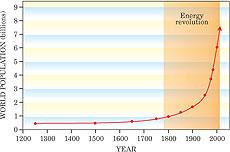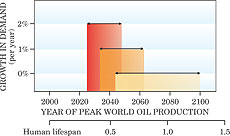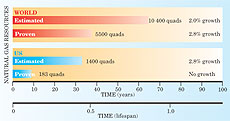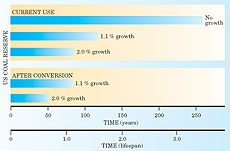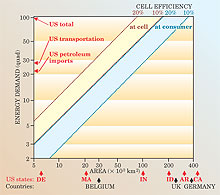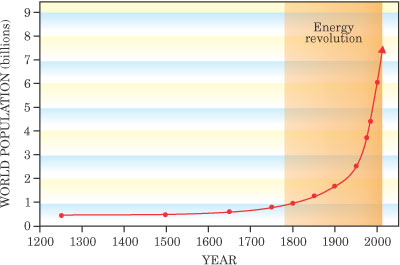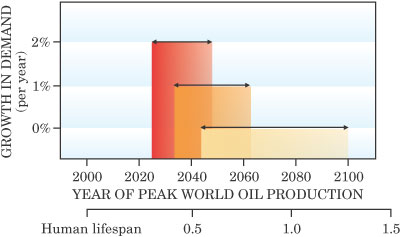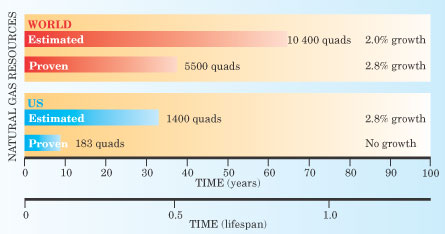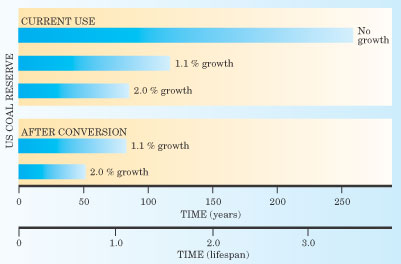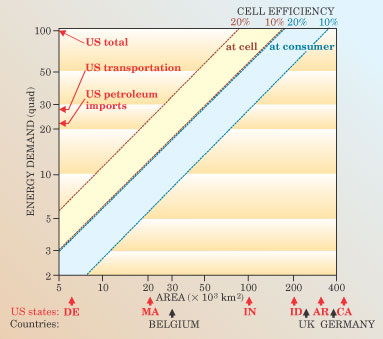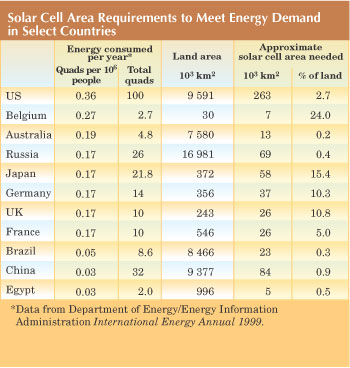| Articles | ||||||||||||||||||||||||||
|
Basic Choices and Constraints on Long−Term Energy Supplies Population growth and energy demand are exhausting the world's fossil energy supplies, some on the timescale of a single human lifespan. Increasingly, sharing natural resources will require close international cooperation, peace, and security. Human society, like any system composed of dynamic processes, depends on an external energy source. Historically, that source was the Sun, which provides heat, light, and photosynthesis for food to support work energy by man and animal, and affects wind and water motion. Since the early 19th century, though, the discovery of and access to a vast supply of fossil fuels within Earth has enabled the industrial revolution, near−exponential growth of population,1 technologies, and wealth. That period could well be renamed the energy revolution (see figure 1).
Our basic choices are limited. Nature's energy resources are confined to two categories: Earth−stored fossil residues and nuclear isotopes, whose economic utility is limited by the finite amounts that exist on Earth, and the radiation flux of solar energy, whose economic utility is limited by the finite rate at which we can capture the Sun's energy and by the land areas that societies can dedicate to harness it. The longevity of the fossil energy supply and the net rate of solar energy availability are both reduced by the energy consumed through their conversion to a suitable energy form and the technologies that accompany that conversion: storage, delivery, maintenance, and repair of environmental damage. Solar−derived consumer energy, whether as electricity, biomass, or wind, represents a clean, alternative energy form. It is important to understand a basic law of nature: Energy, once used, is not regenerable. So the public term "renewable energy" is misleading. The following analysis examines the magnitudes of the world's energy supplies and the basic constraints on our ability to support in the long term society's demands using those finite supplies. To put those magnitudes into a human context for policymakers and the public, the longevity of our resources will be expressed on the scale of a human lifespan (where 1 human lifespan is approximately 75 years).
Energy demands
In viewing overall societal energy issues, it is useful to express energy magnitudes in units of the quad (Q), where 1 Q = 1015 BTU, roughly equal to 2.5 × 1014 kcal or 1.06 × 1018 joule. Current US energy consumption is about 100 Q/year, roughly a quarter of the world's total demand.2 Energy demand by humanity continues to rise. An increase of about 1.5% per year is projected in the US and world demand is expected to increase by 1−2% per year for many decades, mainly due to continued population growth. While total demand is, of course, influenced by personal demand, even unusually large (20%, say) conservation efforts would be nullified by population growth in less than 20 years.
Earth−stored resources
In 2000, Jay Hakes of the Energy Information Administration presented a similar and extensive US Department of Energy assessment of the likely trend and peak in the world petroleum supply.4 Figure 2 shows the predicted range of years when the peak is likely to occur for demand whose growth rate may be between 0−2%. Because growth rates due to population alone are anticipated to be at least 1% per year for many decades to come, the pivotal event is expected to occur well within a human lifespan. Moreover, the analysis was based on an optimistic estimate of the world oil resource of approximately 2200−3900 billion barrels, nearly twice the proven reserve.5 That would place the anticipated time to reach the peak well within a few decades.
High carbon dioxide emissions also accompany the conversion of coal to any motor fuel. For more details on how CO2 complicates the energy problem, see the box on page 50.
To harvest the dilute solid carbonaceous contents requires drastic measures: Either underground combustion, heating, steam, or air to drive the carbonaceous solids toward the surface, or the mining of huge volumes of solids using heat, solvents, and steam to extract the resource. The extracts must be further processed to yield usable hydrocarbon fuels, a process that requires further energy sacrifices. Compared to petroleum, these heavy oils present additional refining and environmental problems because of the abundance of nitrogen, oxygen, and metal compounds found in them. Also, the amount of CO2 released during processing and use greatly exceeds that released by the current use of petroleum fuels.
Constraints on solar energy use
The amount of solar energy received across US latitudes is approximately 22 Q per year per 4000 km2 (about a million acres) on average.8 Technologies based on this resource have the potential to become major contributors to our energy supplies (see Sam Baldwin's article in Physics Today, April 2002, page 62.) Photovoltaic solar cells convert 10−20% of incident radiation directly to electricity. Figure 5 illustrates how large a surface area of cells would be required to generate a particular amount of electricity. The yellow region indicates electricity produced directly at the cell. The blue region is a more realistic mapping and indicates the larger cell areas needed to cover the energy losses in transformers, transmission, power−equalization over time, and efficiency losses that occur for any conversion to gaseous or liquid fuels. Thus about 40−80 thousand km2 of area—roughly 2−4 times the size of Massachusetts—could supply about 20 Q, or 20−25%, of today's US total energy requirements. That amount and more of available land can probably be found in the US. But the size illustrates the magnitude of the technological and social impact. It is instructive to compare what fraction of other nations' total areas would be required to supply their current energy demand. The percentage ranges from as low as 0.2% for Australia to as much as 24% of the land occupied by Belgium (see the table on page 51). The data assume a 15% solar−cell efficiency, and 50% efficiency at the site of consumption. Biomass energy production requires photosynthesis exclusively on fertile land, but it is another much discussed alternative energy. The US has about 1.6 million km2 (400 million acres) of arable land that provides food for the current US population, with about 20% of the food left for export. The US is likely to progressively need that 20% in the next few decades as its population increases. Moreover, the current agricultural productivity depends on fossil fuels to provide the reactive nitrogen required to make fertilizer. Otherwise, about three to four times that 1.6 million km2 of arable land will be needed to provide photosynthetic nitrogen fixation to generate the current food supplies. Quite apart from fertile land requirements, the solar−to−biomass conversion efficiency is very much smaller than for the conversion of solar to electrical energy. Modern agriculture can generate about 1−1.5 million kg of biomass vegetation per square kilometer of land with about 16 000 BTU per kg, for a total of about 0.06−0.09 Q on 4000 km2 of land. However, after accounting for external energy consumed through the agricultural process and the conversion of biomass to a useful fuel, the net energy production, if any, is less than 0.02 Q on 4000 km2—two orders of magnitude smaller than that of photovoltaic cell conversion. That is, biomass conversion would require some 100−fold more area of fertile land. Wind energy is another secondary product of solar radiation. Although few studies have assessed its ultimate technological promise, researchers estimate that the technology could potentially generate a maximum of 3−22 Q of electricity in the US.9 Energy losses due to transmission, supply, and demand fluctuation or conversion to other energies will reduce the actual contribution, but wind energy provides a significant potential resource contribution.
Energy science
Energy availability determines, drives, limits, and shapes the working capability of all processes of society.11 The silent and plentiful gift of energy has fundamentally influenced the application of economic theory as well as the teachings of most other disciplines in the educational system.
This change in economic theory is well illustrated by the silicon photovoltaic cells that brilliantly accomplished their mission in space flight in 1972 at an affordable economic cost. Yet, if they had to provide us with indispensable alternative energy, they would have had to operate continuously for at least 20 years just to replace the energy invested (or consumed) in their production. By 1999, photovoltaic cells were reported to produce their investment energy in about 3−7 years.13 That history illustrates the profound economic importance of the concept of net energy. The economic value of an alternative energy technology depends on the net rate of energy QNE it will deliver after the rate of energy production QPR is debited by the energy consumed for its operation QOP and the energy invested in its creation E during its lifetime T:
QNE = QPR − (QOP + E/T).
For example, ethanol production from biomass, which involves a complex agricultural and industrial processing system that requires large and diverse external energy inputs QOP, easily results in a negative QNE, yet government subsidies can make the production profitable to producers.
More than ever since the beginning of the energy revolution, knowledge of the basic nature and limits of energy is needed to realistically determine and carry out effective policy designed to guarantee reliable energies in the future. That could well help ensure the survival of civilization. As H. G. Wells once remarked, "Human history more and more becomes a race between education and catastrophe."
A knife−edge issue
The major source of the world's energy supply, the fossil fuels, will decline in availability within several decades. It is of paramount importance that the public and policymakers recognize the ensuing shortages and the urgent need for policies that will address them. In particular, an urgent commitment to solar and nuclear energy technologies appears to be mandatory for the long term. Solar energy technology offers the most promising capabilities for the future because photovoltaic cells can generate potentially large quantities of electricity for nations with sufficient land area. Worldwide use, though, will depend on international peace and cooperation. Current uranium fission technologies could provide enough energy for a few decades.14 Advanced fission technologies that involve breeder methodologies and the use of thorium, as envisioned by Edward Teller,15 could extend that timeline to many hundreds of years. Controlled nuclear fusion remains a unique energy alternative of vast magnitude. Moreover, nuclear technologies are not dependent on location and land area. At the moment, public concern over potential risks has virtually stopped the pursuit of this energy source. Peaceful cooperation among nations will be increasingly and vitally important for accessing and sharing our remaining resources. Human society faces no greater risk, however, than ignorance of the basic laws of nature, the role and finite magnitudes of energy sources, the arithmetic of population growth (see Albert A. Bartlett's article in this issue on page 53), and their consequences on the survival of humanity. As Shirley Ann Jackson, president of the American Association for the Advancement of Science, points out (see APS News, October 2003, page 8), "The public policy arena needs the voice of science itself . . . weighing in on knife−edge issues with the voice of reason."
I acknowledge the tireless assistance of David Pimentel, professor of agricultural sciences at Cornell University, for advice on agricultural science; its role in food production, land use, and biomass production; and their relevance to energy issues.
Paul B. Weisz is
an emeritus professor of chemical and bioengineering at the University
of Pennsylvania and a retired senior scientist and manager at the
Central Research Laboratory of the Mobil Corp. He is also currently an
adjunct professor of chemical engineering at the Pennsylvania State
University.
1. United Nations statistics available at http://www.un.org/esa/population/publications/sixbillion/sixbilpart1.pdf.
2. Energy Information Administration, Annual Energy Outlook 2004, rep. no. DOE/EIA−0383(2004), available at http://www.eia.doe.gov/oiaf/aeo; International Energy Outlook 2004 rep. no. DOE/EIA−0484(2004), available at http://www.eia.doe.gov/oiaf/ieo; Annual Energy Review 1999, rep. no. DOE/EIA−0384(99) (2000), available at http://tonto.eia.doe.gov/ftproot/multifuel/038499.pdf.
3. M. K. Hubbert, in Drilling and Production Practice, American Petroleum Institute, Washington, DC (1956); M. K. Hubbert, Am. Assoc. Pet. Geol. Bull. 51, 2207 (1967).
4. J. Hakes, Long Term World Oil Supply, presentation at the 18 April 2000 meeting of the American Association of Petroleum Geologists, New Orleans, LA, available at http://www.eia.doe.gov/pub/oil_gas/petroleum/presentations/2000/long_term_supply.
5. Table 8.1 World Crude Oil and Natural Gas Reserves, 1 January 2003,
Energy Information Administration/Department of Energy update posted on
8 March 2004 for International Energy Annual 2002, available at http://www.eia.doe.gov/pub/international/iea2002/table81.xls
6. National Petroleum Council Committee on Natural Gas, Natural Gas: Meeting the Challenges of the Nation's Growing Natural Gas Demand, vol. 1, National Petroleum Council, Washington, DC (1999).
7. W. Youngquist, Shale Oil: The Elusive Energy, newsletter no. 98/4, M. King Hubbert Center for Petroleum Supply Studies, Golden, CO (1998).
8. W. E. Reifsnyder, H. W. Lull, Radiant Energy in Relation to Forests, US Dept. of Agriculture, Forest Service, Washington, DC (1965); E. P. Odum, Fundamentals of Ecology, 3rd ed., W. B. Saunders, Philadelphia (1971); M. Slesser, C. Lewis, Biological Energy Resources, Wiley, New York (1979); S. B. Weiss, Can. J. Forest Res. 30, 1953 (2000).
9. D. Pimental et al., BioScience 52, 1111 (2002); EIA Monthly Energy Review, DOE/EIA−0035(95/02), Washington, DC (February 1995).
10. R. Shinnar, Technol. in Soc. 25, 455 (2002).
11. P. B. Weisz, in Chemical Engineering in a Changing World, W. T. Koetsier, ed., Elsevier Scientific, New York (1976).
12. N. Georgescu−Roegen, The Entropy Law and the Economic Process, Harvard U. Press, Cambridge, MA (1971).
13. R. Corkish, Sol. Prog. 18, 16 (1997).
14. The Future of Nuclear Power: An Interdisciplinary MIT Study (2003), available at http://web.mit.edu/nuclearpower.
15. E. Teller, Memoirs: A Twentieth−Century Journey in Science and Politics, Perseus, Cambridge, MA (2001), p. 565.
16. US Department of Energy, Office of Fossil Energy, Carbon Sequestration Research and Development, (December 1999), available at http://www.fossil.energy.gov/programs/sequestration/publications/1999_rdreport/front_feb.pdf.
17. M. M. Maroto−Valer et al., Am. Chem. Soc. Div. Fuel Chem. 49, 373 (2004).
Figure 1. World population growth since the 13th century.
Figure 2. Predictions indicate that the peak and subsequent decline in world oil production will probably occur within the next few decades. The data here are based on optimistic estimates that place the oil reserve at 2248−3896 billion barrels. Just how soon the peak will occur depends on annual population growth rates and increases in demand. The given ranges account for uncertainty in predicting the future: For each estimate of projected growth in demand for petroleum—0, 1%, or 2%—there exists a 95% chance that the peak will occur by the year on the left−hand end of the range and a 5% chance that it may occur as late as the year on the right−hand end. (Data from ref. 4.)
Figure 3. Outlook for world and US natural gas capacity, based on current proven gas reserves and on currently estimated resources (including unproven and nonproduceable amounts). The energy content is given to the right of each bar, the length of which indicates the amount of time that the natural gas supply is likely to last. That longevity depends on the annual growth in usage (shown on the far right) that may occur over the next few decades. (Based on data from ref. 6, and ref. 2, Energy Information Administration International Energy Outlook 2004.)
Figure 4. Outlook for the longevity of the US coal supply, based on the current consumption rate and a range of anticipated annual growth rates—up to a 2% increase in demand per year. The two lowest bars indicate the longevity of the coal supply if coal is converted to other fuels. Experts estimate that roughly 54% of the reserve underground—comprising anthracite, bituminous, subbituminous, and lignite rock—is recoverable. (Data from ref. 2, Annual Energy Review 1999.)
Box1: Basic Problems Associated with Carbon Dioxide Emissions
The massive quantities of carbon dioxide currently generated during
fossil fuel consumption are responsible for progressive global warming.
This problem has become a matter of global concern and has led to large
efforts and expenditures for research in technologies designed to
sequester CO2.16
Unfortunately, permanent immobilization confronts fundamental problems. Like H2O, CO2 is a chemically inert molecule. Its only potential reaction partners possibly available in sufficient magnitudes may be mineral oxides—for example, calcium− and magnesium−silicates. They exist in dense geological formations. However, no useful reaction rate is achievable in such locations. Their use would require mining, shipping, grinding, special activation processing,17 and disposal of gigatons of the solids. Most prominent research projects are directed toward massive physical storage of CO2 by injection into those geological formations or within the deep oceans (see Jorge L. Sarmiento and Nicolas Gruber's article in Physics Today, August 2002, page 30). It is difficult to accurately predict the integrity of such physical storage over long periods16 because many variables in complex environments are involved. Attempts to manipulate marine or terrestrial ecosystems and increase the amounts of CO2 these sinks naturally hold are fraught with great complexities that involve multiple and interactive processes.18 Any conversion of a carbonaceous fossil fuel to a fuel of lower carbon content—including the conversion all the way to hydrogen—will eject the excess carbon as CO2. The problem of its emission to the atmosphere is simply transferred from the points of consumption to the location where the conversion process takes place. Therefore, the CO2 problem is not eliminated by a "hydrogen economy" if the hydrogen is created by the conversion of coal, petroleum, or natural gas.
Figure 5. Photovoltaic cell areas required to generate electrical energy that could supply a sizable fraction of the US economy. The yellow area plots the electrical energy produced at the solar cell surface for efficiencies between 10 and 20%. The blue area plots the energy at the consumer side and accounts for losses in transmission, storage, and so forth, in addition to efficiency losses. Some US states (Delaware, Massachusetts, Indiana, Idaho, Arkansas, and California) and world nations provide the scale of the enormous land areas that would be required.
© 2004 American Institute of Physics
|
Sponsored links
|
|||||||||||||||||||||||||
|
||||||||||||||||||||||||||
